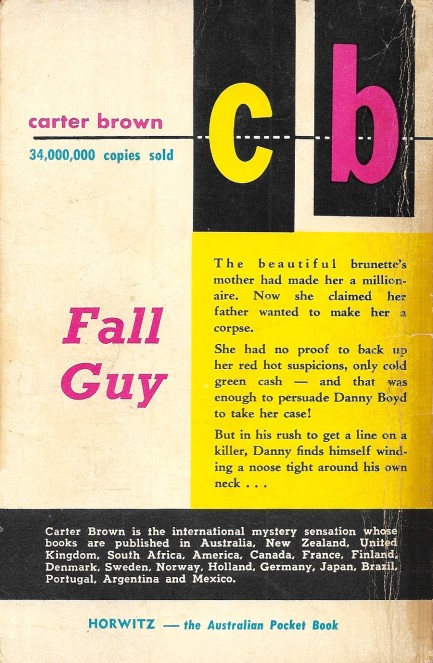 Horwitz Publications perfectly red the paperback market. 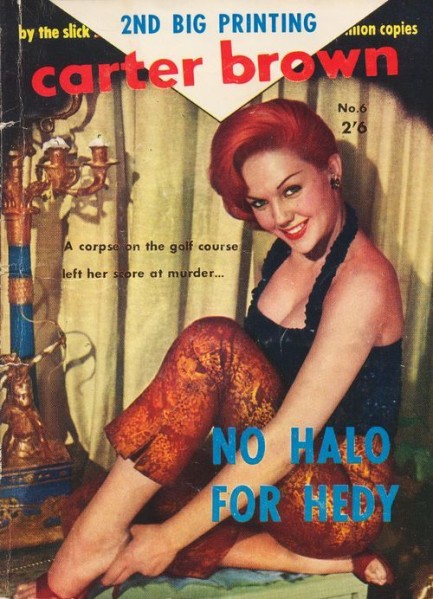
 For a while we were tracking the possibly unlicensed usage by Australian imprint Horwitz Publications of celebrities on its paperback covers. We fell down on the job a bit. The last one we looked at was two years ago. For a while we were tracking the possibly unlicensed usage by Australian imprint Horwitz Publications of celebrities on its paperback covers. We fell down on the job a bit. The last one we looked at was two years ago. The red-haired model used above on Carter Brown's thriller No Halo for Hedy is Playboy centerfold and nightclub performer Colleen Farrington, who was the mother of actress Diane Lane. The book originally appeared in 1956, and the above reprint came in 1959. This photo used for the cover is rare. We've seen no other shot of Farrington in these capri pants. Presumably, at one point multiple frames from the session existed, but time disposes of such items. However, it can't diminish the beauty of this cover. You can see all of our Horwitz celeb covers by clicking here.
 Hi, this is Elke calling from Down Under. Can I speak to my agent? There's been a trademark infringement. 
As usual the Aussie publishing company Horwitz has used a film star on one of its book covers—this time German goddess Elke Sommer on the front of 1959's Terror Comes Creeping. She was a favorite of theirs—we've seen her on four covers, including this one, and we've speculated that they're all unlicensed, for reasons discussed here. This one stars Carter Brown's, aka Alan G. Yates's franchise sleuth Danny Boyd, who's hired by a woman named Martha Hazelton who thinks her father is killing off his children—with her next in line—in order to avoid losing his dead wife's inheritance. The father, when confronted by Boyd, says that insanity runs in the family and his daughter is paranoid and probably nuts. It certainly seems that way when Boyd meets his client's loopy, danger obsessed little sister, but of course matters soon begin to look far more complicated than they seemed at first. On one level it's amazing Carter Brown sold something like 120,000,000 books, because his work is not special. But on the other hand it's fast, sometimes funny, and hits the right notes for detective novels. So maybe his success isn't so strange after all. We'll probably read another, because we have a few.
 What happens next could be great or terrible, depending on how well you distinguish subtle shades of color. 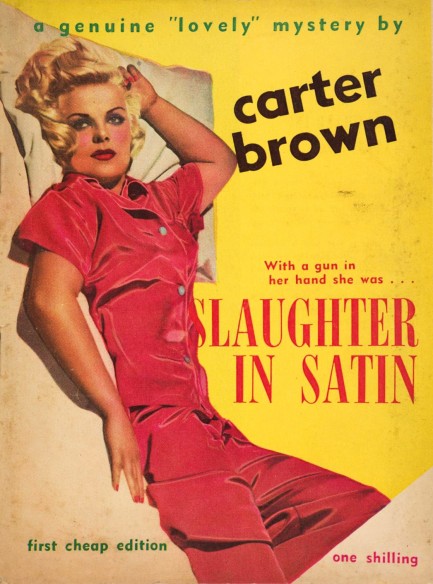
Since we just saw Cleo Moore why not bring her right back? Here she is on the front of Carter Brown's Slaughter in Satin, 1954, from the Australian publisher Horwitz. We've long documented this publisher's usage of minor celebrities on its covers, and pondered whether it was copyright infringement. What caught our eye about this example, besides Moore, was the typesetting. Notice how the “s” in the title disappears into Moore's red jammies, so at first glance it reads as, “Laughter in Satin,” which is almost an opposite outcome from slaughter, like the difference between being lain or slain. Probably when the book was first printed the two shades of red stood out from each other more. Or maybe this visual trick was intentional. Or maybe it was a miscalculation that couldn't be repaired. We'll never know. See the other Moore here, and see the celeb Horwitz covers by clicking here and scrolling.
 Horwitz Publications puts a Hollywood starlet to bed. 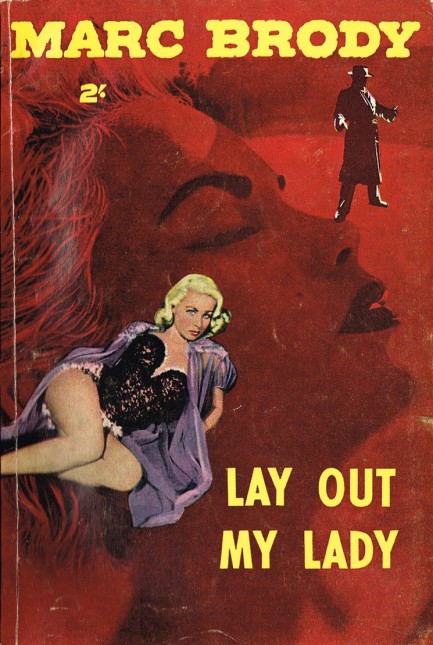
Above is a cover from Australian imprint Horwitz Publications for Marc Brody's thriller Lay Out My Lady, published in 1956. We've long featured Horwitz covers because they used photo-illustrations of famous or soon-to-be-famous actresses. This time the company chose U.S. actress and beneficiary of lucky genes Joi Lansing, clad in the sort of extravagant bedtime wear that was popular during the era, and whose time-defying beauty we've marveled over here and here. And here too. The face in the background is also an altered photo, though not of Lansing. We can't identify her. If you have any ideas feel free to inform us.
Moving on to Marc Brody, he was both the author and star of these yarns, and claimed to be an intrepid crime reporter. That would be fascinating if it were true, but it wasn't. He was actually author William H. Williams, aka Bill Williams, and he wrote novels while sitting in a shed in his garden, which is about as far from the mean streets as anyone can get. But you have to give him credit—he churned out something like eighty of these books. We'll be revisiting him later. In the meantime you can see a bit more from him—including photo-illustrations of another beautiful actress—at this link.

 American star adds pizzazz to a pair of Aussie thrillers. 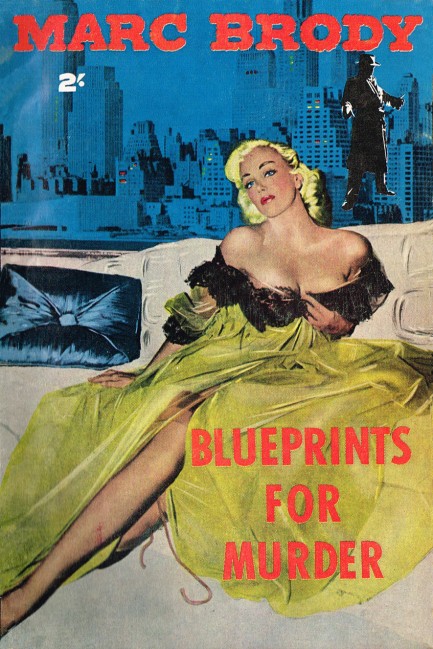 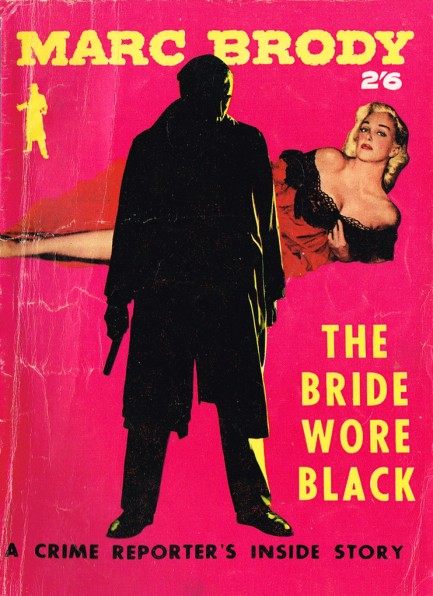
Today we have two more paperbacks from Australia's Horwitz Publications, a company that, as we've documented often, opportunistically used numerous Hollywood celebs on its covers. This time it's Jan Sterling, who appears on 1955's Blueprints for Murder and 1956's The Bride Wore Black, both written by the prolific Marc Brody. Sterling was never a top tier actress but she was in a lot of good movies and earned an Oscar nomination for The High and the Mighty. She also posed for some stunning photos, including the two at this link. These book scans float around online, which means we don't know where they originate, but if we had to guess we'd say Flickr, so thanks to the first uploader.
 Lee provides the style, Laffin provides the substance. 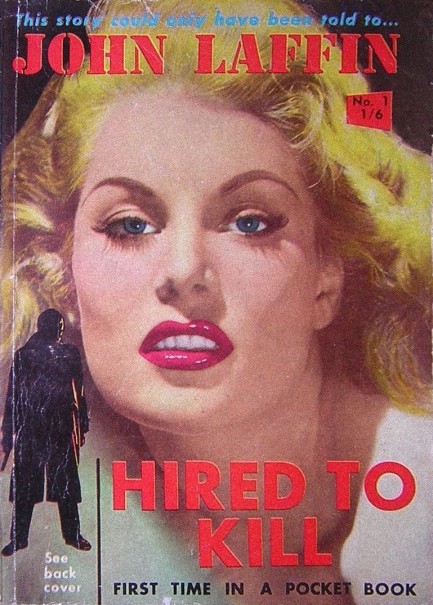
We're back to Horwitz Publications and its appropriation of Hollywood stars for its covers. If you haven't seen those they're all worth a look because of their usage of rare images. On the above cover from 1957's Hired To Kill, the face belongs to Belinda Lee, and as always the taste of Horwitz editors is impeccable. But Lee wasn't long for this world. She was just establishing herself as one of Britain's best exports when she became a road casualty during an ill-fated 1961 drive from Los Angeles to Las Vegas.
Moving on to John Laffin, he was one of those authors whose brand was being a real-life adventurer. He was supposedly an ex-commando who was an expert with rifles, martial arts, and throwing knives, and who also spoke five languages. He'd visited thirty-two countries at the time of publication of this novel and was busy adding to the number, according to the rear cover text. And apparently he had been published in fourteen countries and five languages, which makes it a bit embarrassing we'd never heard of him.
We checked out his bibliography and sure enough, the guy wrote a pile of books. Many of them were war biographies and political analyses. He mainly focused on the British experience in World War I, but wrote everything from adventure fiction to an “expert”—i.e white guy's—analysis of the Arab mind. He sounds like an interesting fella, so we may look what's out there that we can acquire for a reasonable price and see what his fiction is like. If we do we'll report back.
 She was so good Horwitz had a second helping. 
Senta Berger makes a second appearance on a Horwitz Publications paperback cover, this time for Carter Brown's Murder Is My Mistress. We showed you the Horwitz cover for Brown's Swan Song for a Siren a while back. That actually came second of the pair and was numbered 34 in the company's Reprint by Demand series. The above is number 19 and was published in 1960. We found it on the Nick Carter & Carter Brown blog, which is a stop you should make if you want to know everything about Brown. Anyway, we've been discussing these Horwitz paperbacks for a while because of their celebrity covers. In using Berger twice the publisher chose well.
 Horwitz unclutters the view on Chandler's classic. 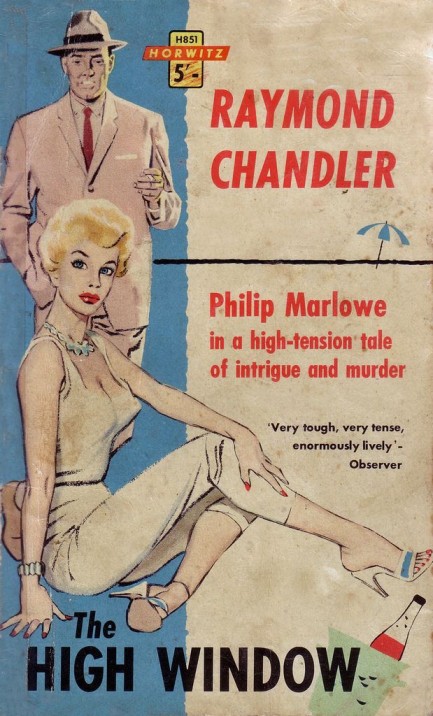
Above is a nice alternate cover for Raymond Chandler's The High Window from Australia's Horwitz Publications, circa 1961. It's a cleaner, less plot revealing, and less controversial piece than the battered wife cover put out by American publishers Pocket Books in 1955. We found it on Flickr, so thanks to the original uploader. Sadly, the art is uncredited, which is the way Horwitz generally did business, those damn Aussies.
 American singer gets booked for special engagement Down Under. 
We love documenting the appropriations of celebrities by Horwitz Publications. This time the company snares U.S. nightingale Abbe Lane for its 1955 edition of Carter Brown's Swan Song for a Siren. You see the original photo they worked with below, which also features Lane's husband Xavier Cugat in the left background, erased by Horwitz's graphics guru and replaced by a man with a gun. The company would reprint this title in 1958 with Senta Berger on the cover, because once you get a taste for kidnapping celebrities you never stop. You can see that edition here. And if you want to see more examples of celebrity theft click the Horwitz keywords below.
 I want the cash, the jewelry, and the licensing fees or I'll blow your brains out.  
We're back to charting Horwitz Publications' unlicensed usage of celebrity images for its paperback covers. We've already talked about Joan Collins, Senta Berger, Elke Sommer, Lili St. Cyr, and others. This time the company borrows Belgian actress Dominique Wilms. The image chosen was originally used as a promo photo and the basis of the promo poster for her 1953 film debut La môme vert de gris, aka Poison Ivy. We're convinced now that Horwitz, which was based in Australia, did this because copyright agreements were lax or nonexistent regarding image licensing across international borders. And even if some rules were on the books, it's very possible Wilms and her management never saw the above cover, and if they did decided it wasn't worth a legal fight. The Horwitz guys were sneaky bastards. But as we've asked before, why bother? Wilms was so obscure at this point that Horwitz gained nothing from using her face. Don't get us wrong—she has a great face (and everything else too). But Horwitz could have simply used local models and produced identical results. That's the part we'll never get. But we've queried an expert about stolen paperback imagery and we'll share his answer soon. Note: Very soon. See here.

|
 |

The headlines that mattered yesteryear.
2003—Hope Dies
Film legend Bob Hope dies of pneumonia two months after celebrating his 100th birthday. 1945—Churchill Given the Sack
In spite of admiring Winston Churchill as a great wartime leader, Britons elect
Clement Attlee the nation's new prime minister in a sweeping victory for the Labour Party over the Conservatives. 1952—Evita Peron Dies
Eva Duarte de Peron, aka Evita, wife of the president of the Argentine Republic, dies from cancer at age 33. Evita had brought the working classes into a position of political power never witnessed before, but was hated by the nation's powerful military class. She is lain to rest in Milan, Italy in a secret grave under a nun's name, but is eventually returned to Argentina for reburial beside her husband in 1974. 1943—Mussolini Calls It Quits
Italian dictator Benito Mussolini steps down as head of the armed forces and the government. It soon becomes clear that Il Duce did not relinquish power voluntarily, but was forced to resign after former Fascist colleagues turned against him. He is later installed by Germany as leader of the Italian Social Republic in the north of the country, but is killed by partisans in 1945.
|

|
|

It's easy. We have an uploader that makes it a snap. Use it to submit your art, text, header, and subhead. Your post can be funny, serious, or anything in between, as long as it's vintage pulp. You'll get a byline and experience the fleeting pride of free authorship. We'll edit your post for typos, but the rest is up to you. Click here to give us your best shot.

|
|


 For a while we were tracking the possibly unlicensed usage by Australian imprint Horwitz Publications of celebrities on its paperback covers. We fell down on the job a bit. The last one we looked at was two years ago.
For a while we were tracking the possibly unlicensed usage by Australian imprint Horwitz Publications of celebrities on its paperback covers. We fell down on the job a bit. The last one we looked at was two years ago.

